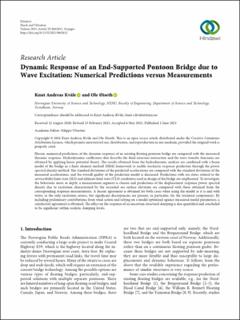| dc.contributor.author | Kvåle, Knut Andreas | |
| dc.contributor.author | Øiseth, Ole Andre | |
| dc.date.accessioned | 2022-11-22T07:39:25Z | |
| dc.date.available | 2022-11-22T07:39:25Z | |
| dc.date.created | 2021-12-09T14:05:14Z | |
| dc.date.issued | 2021 | |
| dc.identifier.citation | Shock and Vibration. 2021, 2021 . | en_US |
| dc.identifier.issn | 1070-9622 | |
| dc.identifier.uri | https://hdl.handle.net/11250/3033239 | |
| dc.description.abstract | Herein, numerical predictions of the dynamic response of an existing floating pontoon bridge are compared with the measured dynamic response. Hydrodynamic coefficients that describe the fluid-structure interaction and the wave transfer functions are obtained by applying linear potential theory. The results obtained from the hydrodynamic analysis are combined with a beam model of the bridge in a finite element method (FEM) framework to enable stochastic response prediction through the power spectral density method. The standard deviations of the predicted accelerations are compared with the standard deviations of the measured accelerations, and the overall quality of the prediction model is discussed. Predictions with sea states related to the serviceability limit state (SLS) and ultimate limit state (ULS) conditions used in design of the bridge are emphasized. To investigate the behaviour more in depth, a measurement segment is chosen and predictions of the displacement response power spectral density due to excitation characterized by the recorded sea surface elevation are compared with those obtained from the corresponding response measurements. A decent agreement is obtained for both cases when using the model as it is and with waves as the only excitation source, but significant discrepancies are present, in particular, for the torsional components. By including preliminary contributions from wind action and relying on a model optimized against measured modal parameters, a satisfactory agreement is obtained. The effect on the response of an uncertain structural damping is also quantified and concluded to be significant within realistic damping levels. | en_US |
| dc.language.iso | eng | en_US |
| dc.publisher | Hindawi Publishing Corporation | en_US |
| dc.rights | Navngivelse 4.0 Internasjonal | * |
| dc.rights.uri | http://creativecommons.org/licenses/by/4.0/deed.no | * |
| dc.title | Dynamic Response of an End-Supported Pontoon Bridge due to Wave Excitation: Numerical Predictions versus Measurements | en_US |
| dc.type | Peer reviewed | en_US |
| dc.type | Journal article | en_US |
| dc.description.version | publishedVersion | en_US |
| dc.source.pagenumber | 18 | en_US |
| dc.source.volume | 2021 | en_US |
| dc.source.journal | Shock and Vibration | en_US |
| dc.identifier.doi | 10.1155/2021/8842812 | |
| dc.identifier.cristin | 1966697 | |
| cristin.ispublished | true | |
| cristin.fulltext | original | |
| cristin.qualitycode | 1 | |

